This is an Argus C33, a 35mm rangefinder produced by the Argus Corporation in Ann Arbor, Michigan between the years 1959 and 1961. The C33 was an oddly designed, but ambitious update to the original C3 which added many features that had become standard for rangefinders in the years after the original camera’s release. These included a larger and brighter viewfinder with a coincident image combined rangefinder, an improved bayonet interchangeable lens mount, lever wind film advance, and an optional coupled selenium cell exposure meter.
Film Type: 135 (35mm)
Lens: 50mm f/3.5 Cintar coated 3-elements
Lens Mount: Argus C33 Bayonet
Focus: 3 feet to Infinity
Viewfinder: Coincident Image Coupled Rangefinder
Shutter: Behind the Lens Leaf
Speeds: B, 1 – 1/300 seconds
Exposure Meter: Clip-On Coupled Selenium Cell
Battery: None
Flash Mount: Coldshoe with Argus Flash Unit (M-sync only – No X-sync, see below)
Weight: 1007 grams
Manual: http://www.cameramanuals.org/argus/argus_c-33.pdf
History
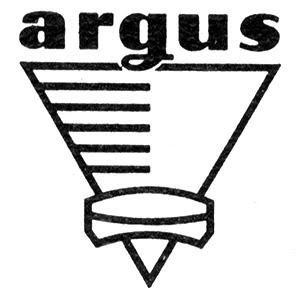 With the exception of the Eastman Kodak Company, Argus was once the most successful of all American camera companies during the 1930s through the 1960s when the company stopped producing it’s own models, and instead became a “badge” applied to camera models made by other companies.
With the exception of the Eastman Kodak Company, Argus was once the most successful of all American camera companies during the 1930s through the 1960s when the company stopped producing it’s own models, and instead became a “badge” applied to camera models made by other companies.
Originally founded in Ann Arbor, Michigan as the International Radio Corporation (IRC) in 1931 by entrepreneur Charles A. Verschoor, the company produced a large lineup of portable and tabletop radios. Argus employed the use of Bakelite, an early form of plastic, in all of it’s models which helped keep the costs down, while still being able to mimic the look of wooden and metal cameras made by other companies.
One of IRC’s products was the Kadette which was the first mass produced AC/DC radio. It sold extremely well and allowed IRC to release other Kadette products like the Kadette Jr, which was the world’s first pocket radio, and the Kadette Clockette which was one of the first clock radios.
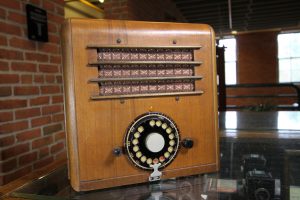
In the first half of the 1930s, IRC’s radio business was so successful as it was the only company in Ann Arbor that was able to pay dividends to it’s share holders during the Great Depression. Nearby Detroit was heavily hit by the recession, so in the entire state of Michigan, IRC was one of the few financial bright spots.
By the mid 30s as the depression dragged on and other competing radio manufacturers were able to make inexpensive radios that ate into IRC’s profits, the company saw the need to diversify it’s product offerings.
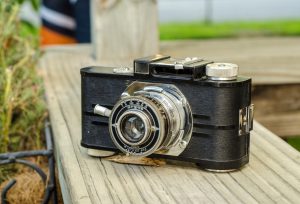
Utilizing the company’s success with Bakelite and electronics, the company released the Argus Model A camera in 1936 to immediate success. Like it’s radios, the Argus Model A was an inexpensive product made almost entirely of Bakelite, and made cameras affordable to those who wouldn’t have otherwise been able to afford one. The price of the Argus A in 1936 was $10 (some sites say $12.50) which meant it could be afforded by the average lower to middle class family. The Argus A was so successful that the company’s primary focus shifted from radio to camera production and they dropped the word “Radio” from it’s name, becoming the International Research Corporation. In 1939, the name would change once again to the Argus Corporation. Argus produced several variants of the Model A both before and after the war, but it’s greatest success would come from it’s second model, the Argus C.
Released in 1938, the Argus C was an ambitious camera that had the lofty goal of offering many features available in much more expensive German models, while retaining a price that still kept it within reach of the working class American family. IRC used it’s extensive experience to create a mostly Bakelite body with molded (instead of machined like the Germans used) metal front and back plates to keep costs down. The target price for the Argus was $25 which was the average weekly salary of an American family in 1938.
The Argus C had an interchangeable lens mount, a split image rangefinder, top plate shutter release, and came standard with a 3-element Cintar lens that was based off an earlier Cooke triplet design. Very shortly after the release of the C came the C2 and C3 which each added a coupled rangefinder, and flash synchronization.
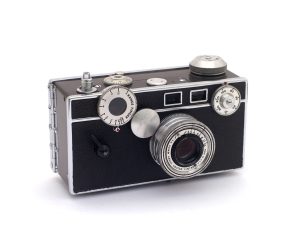
The Argus C3 would be enormously successful for Argus and would remain in production until 1966, an astounding 28 years after it’s introduction. To put that into perspective, as I write this in 2018, 28 years ago was 1990 when the most advanced video game console was the Sega Genesis, the fastest desktop PC processor was the Intel 486-DX 33MHz, and 27″ CRT TVs were still considered “big”.
Although the C3’s production length was impressive, it’s stance as a modern camera for all but the most basic photographer faded shortly after the war. Argus was only able to continue production of the camera by simplifying the exposure system, adding a clip on meter, and changing the color of the camera and selling it at a discount price. The camera’s poor ergonomics and 1930s technology prevented it from competing with other models sold to professional and advanced amateur photographers.
Realizing that they needed to come up with something new, Argus made the wise decision to release an all new model with many modern features, but would also make the very curious decision to retain the original C3’s brick like shape, except making it both larger and heavier, and call it the C33.
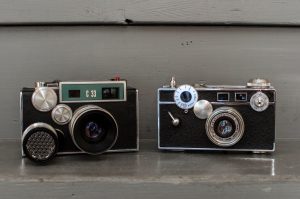
The name “C33”, brick like shape, and similar externally coupled rangefinder gears might suggest that this was simply a heavily updated C3, but as best as I can tell, the C33 shared no internal or external parts with the C3. Maybe a screw here or there was reused, but the design is completely different. The only possible explanation I can come up with is perhaps Argus thought that because they had sold over 2 million C3s by this point that there would be a huge customer base who wanted something more advanced, but still familiar in design.
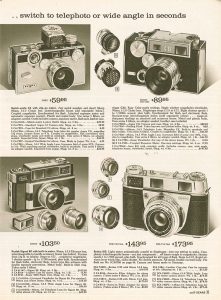
The C33 sold for $89.95 in the 1960 Sears Camera Catalog with the clip on meter costing an extra $17.95 for a total price of $107.90, which when adjusted for inflation is about $900 today, making it quite the investment for potential customers. This was a big jump in price from a Standard C3 at $38.95 and a C3 Matchmatic at $59.95. For the extra money, the C33 improved (or in some cases, just changed) upon the C3 in the following ways:
- Completely new and much simpler interchangeable bayonet lens mount
- Larger and brighter viewfinder with a combined coincident image rangefinder
- Advanced 9 speed shutter with speeds from 1 second to 1/300 (I cannot confirm this but I believe the lens to be a Compur design)
- Optional coupled clip-on selenium cell exposure meter (the Matchmatic had a clip on meter too, but it was not coupled)
- Self cocking lever film advance and flip up lever rewind handle
- A bottom hinged rear door that was said to allow for easier film loading (this is debatable)
- A new take-up drum which was designed to simplify film loading (also debatable)
- A unique exposure counter reminder that forces you to reset the exposure counter to either 20 or 36 before you can close the rear door (while this probably seemed like a good idea to prevent people from loading in a new roll of film and forgetting to rest the exposure counter, it is in practice a pain in the butt, and not compatible with 12 or 24 exposure rolls of film).
- Expanded range of lenses, including a faster f/2.8 50mm Cintar lens.
- Full compatibility with all Series VI filters and attachments
- M and X flash synchronization (this is actually misleading, as Argus’s version of X-sync was not actually for electronic flashes, rather was a 1/30 sync for Sylvania M25 or M2 flash bulbs)
On paper, these changes seemed like huge advances to the C3 (they were), but it’s extraordinarily large and heavy dimensions made it a very tough sell. Perhaps the nail in it’s coffin was that by the time the C33 went to market, Argus already had a model called the C44 which debuted 3 years earlier with many of the C33s features, in a much more attractive and compact body that likely impeded sales and confused customers considering the model. The C33 was short lived, being produced for barely over 2 years.
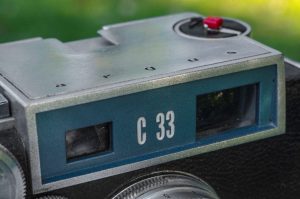
The C33 ended up being a far cry from the success of the C3, and sold very poorly. I could not find any indicator of how many were made, but a quick search on eBay for the Argus C33 produces only 2 currently for sale, and another 5 sold in the previous few months suggesting an extremely limited production of maybe a few thousand.
Sadly, the C33’s failure foreshadowed continued struggles at Argus and the entire American camera industry. By the 1960s, most American camera companies had either gone out of business, or transitioned into other industries. By the end of the decade, the Eastman Kodak company would stop producing any cameras in the United States. The name “Argus” still exists today, but not as the same company it once was, merely being applied as a trademark on cheap digital cameras.
Today, there are those who specifically collect Argus cameras, and for them, the C33 is a curious piece of the company’s history with a very unique design, but it’s highly unlikely many people would go out of their way to buy one.
Repairs
The Argus C33 arrived to me in good working order, so I was able to use it without needing any repairs, but sadly, it stopped working shortly after loading in my first roll. In my search online for repair information, I found this parts guide on the Argus Collectors Group website, which isn’t quite a repair manual, but it has exploded diagrams which should help anyone wanting to take it apart.
Looking at these illustrations, I discovered that the Argus C33 uses some sort of string or cable that connects the advance lever to the shutter (see page 7). I’ve seen other cameras like the Kochmann Reflex-Korelle and the Kodak Retina Reflex who use strings like this too, but I find it curious that Argus would do this. I have a feeling that this string broke on mine which is preventing the shutter from cocking correctly.
I haven’t yet taken the time to disassemble the camera in an attempt to repair it, but I’ll post the guide here for anyone who might be interested in it. Click on each image for a full size view.
My Thoughts
Like many collectors, the Argus C3 was one of the first cameras I owned before I even considered myself a collector. C3s are so ubiquitous (at least in the United States) that they’re a camera you can unintentionally collect as they seem to show up in lots with other cameras. Despite the brick like design, poor ergonomics, and primitive feature set, the C3 is actually a quite capable camera. The Cintar triplet is capable of some really good shots, and there are many people, myself included, who are loyal fans of the camera.
But for all of it’s strengths, it does have quite a few drawbacks. You have to really be in the mood to shoot a C3 as it requires quite a bit of concentration to properly use. It’s not a spontaneous camera you’d take to a park to shoot a 4 year old running around or to a sporting event to capture fast action shots. The viewfinders are small, and unless you’ve done a thorough cleaning, they are almost always cloudy and hard to see through. The rangefinder can easily fall out of adjustment, and the focus on the camera is slow.
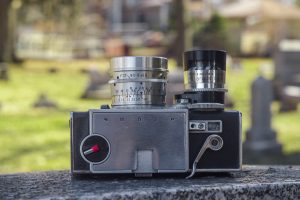
When I found out that there was an Argus “brick” that improved on the shortcomings of the C3 in almost every way, I was pretty excited. Then I actually held one.
Now don’t get me wrong, I like the C33. It is a very unique camera with a very good feature set. Stephen Gandy’s Camera Quest site has an excellent review of the C33 chock full of tongue in cheek humor where the author intentionally pokes fun at the design and implementation of the camera. The author starts out the review saying:
You see, the Argus C-33 is the brick that wanted to be the Leica. That’s right, I love ’em. They make me laugh. In fact, the C-33 is by far my favorite Argus. I write that seriously….but with a smile on my face. Today the C-33 is not that common, but a complete C-33 outfit is difficult to find. That’s right camera fans, brace yourself for what is sure to be a bad dose of camera lust.
I like how he used the term “camera lust” as that’s pretty much how I felt after reading his article. The C33 is the ugly duckling of the camera world, especially with the optional CM2 meter attached. This thing is just downright silly, but once you look past all of the sharp corners, the excessive 2+ pound weight, the swaths of chrome on the sides and top, and the massive back door, you actually have quite a capable camera.
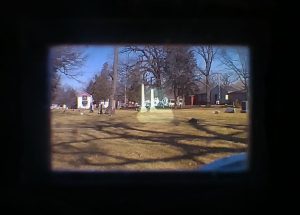
The viewfinder on the Argus C33 is quite good, really good in fact. The coincident image rangefinder is a trapezoidal shape with excellent contrast making quick focus in low lighting easy. The geared focus wheel on the front of the camera is quite useful for precise focus changes, not unlike a Contax or Nikon rangefinder. The exposure meter, as ridiculous as it looks, works quite well, and in fact, when is mounted, makes changing shutter speeds easier as you can see your selected speed from the top of the camera, rather than having to look directly at the front of the camera without it.
The shutter on the C33 is much improved from the one on the C3, and although they both have the same 1/300 top speed, this one goes down to 1 full second. More importantly though, the new shutter actually sounds like a real camera shutter this time, with a confidence inspiring ‘snick’ each time the shutter fires. This is a vast improvement from the loud metallic “PING” of the C3. When slow speeds are selected, you hear a familiar mechanical governor not unlike those found on German Compur or Prontor shutters. In fact, I have a theory that the shutter in the Argus may actually be German, as the Argus Autronic series which immediately followed the C33 and shares the same body, has a Compur shutter in it. It would seem odd to me that Argus would go through the effort to design a completely new shutter for a low selling model like the C33, only to switch to an imported one for the very next model.
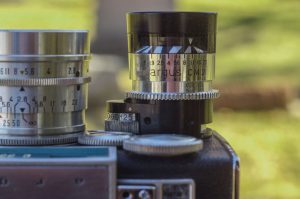
The Argus CM2 meter which was designed for this camera and the Argus C4R is one of the strangest I’ve seen and almost looks like a second lens protruding out of the body. It attaches to the camera via a horizontal post and when attached, completely covers the shutter speed dial on the front of the camera.
Since you can no longer see the camera’s shutter speed dial with the meter installed, it has it’s own, much larger wheel for changing shutter speeds, and conveniently, a second dial with the selected shutter speeds displayed on it. The selected speed points up, and is easy to see from the photographer’s perspective.
The meter uses a selenium cell which means no batteries are required, and amazingly, the example here seems to work fine. It has a white needle that responds to the detected light and depending on which shutter speed you have selected, it will point to an appropriate f/stop that you will have to manually set on the lens. For someone not used to light meters from the 1950s, this might sound archaic, but it actually works quite well and was consistent with other cameras of the day.
Although the C33 offered many improvements from the C3, it wasn’t perfect either. Some of the improvements to the lens mount, and other areas of the company didn’t seem to be all that well thought out and probably contributed to the camera’s demise.
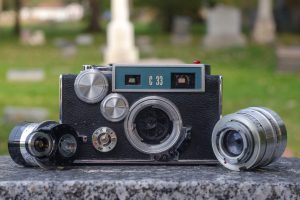
I only ever had one lens for the camera, so I didn’t have a need to change lenses. Although the new bayonet mount is a significant improvement from the “process” required to swap lenses on the original C3, it’s still not as seamless as other bayonet designs as it requires precise alignment of dots to get the lenses on and off.
Getting the lens off the camera isn’t obvious, as it requires you to first set the focus to infinity, and then squeeze a release catch awkwardly located near the bottom of the camera while simultaneously rotating the lens to remove it. Reinstalling a new lens doesn’t require quite as much dexterity, but you do need to make sure the red dots on the back of the lens line up with a red dot on the lens mount, otherwise it won’t couple correctly.
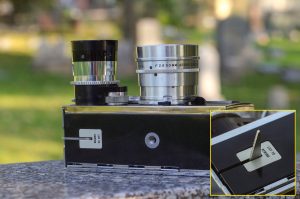
Another oddity is the design of the rewind release on the bottom of the camera. Rather than include a simple button like pretty much everyone else, Argus made the rewind release a pointy spike that looks like something straight out of a spy movie. It reminds me of a cane or umbrella that has a switchblade knife that can pop out of the end of the handle for discreet assassinations.
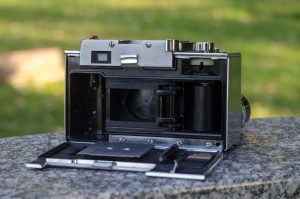
Loading film requires pressing up on a metal latch on the top center of the rear of the camera. The door is hinged on the bottom and once open, reveals a somewhat normal film compartment. Before loading in a new cassette, you must pull up on the rewind crank to pull the fork out of the way. Insert a new cassette and extend the leader to the take up drum. Keeping with the many oddball design elements of this camera, the way in which you attach the film leader to the drum is unlike any I’ve seen.
There are no notches or any slits for you to insert the leader into. The entire drum is a solid piece of plastic except for two metal hooks that are designed to grab the perforations on one side of the leader. Rest the film leader on the drum while rotating the drum using the wind crank until the metal hooks grab one of the perforations of the film leader. While still providing pressure with your hand, give the camera a full wind to rotate the drum and start pulling the film tight across the film gate. I am probably making this sound more confusing than it really is, as it’s one of the few strange things about this camera that actually works well. I wouldn’t quite call this a “Quick Load” system, but it at least showed that Argus was experimenting with something new. Once you are sure the film is securely attached to the leader, you are ready to close the door. Wait a minute, the door won’t close? Read on…
Yet another head scratcher is a “feature” of the camera that was likely designed as a way to remind users to reset the exposure counter after loading in a new roll of film. The C33 has an exposure counter like those found on the Kodak Retina which counts backwards showing the number of exposures remaining on the roll. Also like the Retina, it predates the widespread use of automatic resetting exposure counters requiring you to manually reset it after loading in a new roll of film.
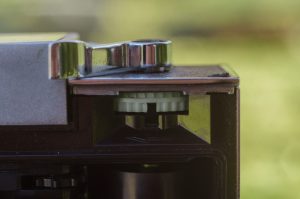
Argus decided to help users by creating a way in which you cannot close the back of the camera unless the exposure counter is set to either 20 or 36. How this works is that there is a plastic wheel in the film compartment with two notches in it that prevent the door from being closed unless the notches line up with a metal catch that’s on the door. The notches in the wheel coincide with the numbers 20 and 36 on the exposure counter. If the counter is at any position other than 20 or 36, the notch doesn’t line up and therefore, you cannot close the door. In the image to the left, I have the notches in the correct position to close the door.
The most obvious problem with this is that 20 exposure rolls went out of production in the early 1980s and now we have 24 exposure rolls which this system can’t account for. It also doesn’t account for 12 exposure rolls which were available when this camera was designed. The only way to use 12 or 24 exposure rolls is to intentionally set the exposure counter wrong.
I can certainly appreciate Argus’s desire to create a way that reminds users to reset the frame counter as I can say that I have forgotten to do this many, many times. But their approach can best be described as “misguided” and frankly a pain in the butt!
Aside from the egregious design and it’s 2.2 lb weight, the Argus C33 is more good than bad, and where it’s bad, its not even that bad. Argus made a valiant attempt at sticking to the boxy design cues of the C3, while still offering modern features, but they ultimately failed, which is a shame because had the C3 been updated sooner with some of these features, I think Argus could have been more successful.
I still like the C33 though. I love American cameras, and I love ones with quirks, and boy does the C33 have quirks! After seeing that the camera appeared to be in good working order, I eagerly loaded in a roll of film and went shooting.
My Results
As I’ve done every year since I starting writing camera reviews, I went up to visit family in northern Michigan for Christmas, and with me I brought an Argus camera. It’s my way of bringing these cameras back “home” to shoot some local Michigan scenery. I’ve done this with my first Argus C3 Matchmatic, the Argus A2F, and the Argoflex EF. The weather is usually rather bleak and overcast in this part of the country at this time of the year, but I still try to do my best to capture some interesting photos. I loaded in some general purpose Fuji 200 color and hit the road.
At first, my experience with the C33 was pretty uneventful. Putting aside the poor ergonomics and sharp corners of the body, the C33 was surprisingly easy to use. The large viewfinder and coincident image rangefinder are worlds ahead of the tiny split viewfinder in the original C3. The wind lever, although long, is comfortably located and a lot faster than the knob wind and film lock release that you must press to advance the film on the C3. Although the C33 retains the C3’s top focus wheel, I found that focusing the lens directly felt most comfortable and that too, was uneventful.
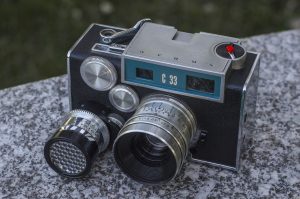
Sadly, after the 7th exposure, I noticed the shutter stopped firing. I could cock the shutter and advance the film, but pressing the shutter release no longer exposed any images. Being 6 hours away from home and on the side of the road in rural northern Michigan, I didn’t have much in the way of tools to try and diagnose the problem, so I put the camera away and pulled out another that I had with me.
After getting home and fiddling with the camera, I determined the camera was beyond repair. A look through the Parts List that I have included above, the shutter is cocked via a cord (Part # 98252-1) that I believe has snapped. Replacing it would require a parts C33 which I do not have. I rewound the film back into the cassette and transferred it into another camera.
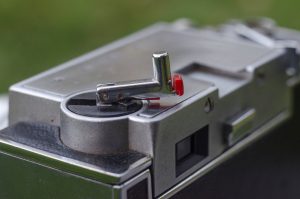
The images above represent 4 of the 7 that I shot and none of them are all that interesting. They do show a nice out of focus detail in the bird feeder shot, and some relatively good sharpness in the lake shot, but otherwise I do not know if I can make any conclusions on the quality of images this camera is capable of. It’s worth noting that the Cintar lenses on the Argus C3 are generally pretty good, so it’s probably safe to assume that the C33 should be comparable.
Today, if you were a collector looking for a vintage camera to shoot, would I recommend an Argus C33? Absolutely! This thing is a heavy brick of a camera with hilariously odd combinations of curious design decisions and some of the worst ergonomics ever seen on a camera, yet somehow, it works! The viewfinder is surprisingly good, the meter works well, precision focus is easy with the top mounted focus wheel, and you can interchange lenses for different focal lengths (assuming you have some).
I regret that my camera was unable to complete a roll and that it’ll likely never shoot another again, but I enjoyed my time with it. I don’t know that I’ll ever go out and specifically seek out a replacement, but if one were to come my way for a cheap price, I’d be hard pressed to pass it up!
My Final WordHow these ratings work |
The Argus C33 updates the original Argus C3 with many modern advancements, including a larger and very easy to use coincident image rangefinder, a lever wind film advance with double exposure prevention, an all new and much simpler bayonet lens mount, and an optional coupled exposure meter. Yet despite these improvements, Argus made some really strange design decisions, and curiously stuck with the brick shape of it’s predecessor making for an ungainly camera with some of the worst ergonomics I’ve ever seen on a camera. But therein lies it’s charm. This is the ugly duckling in a way that only Argus could have made, and somehow it works well. This isn’t a camera I would recommend to just everyone, but if you like quirks and film cameras, it doesn’t get much better than this. | ||||||
| Images | Handling | Features | Viewfinder | Feel & Beauty | History | Age | |
| 1 | 0 | 2 | 2 | 1 | 1 | 20% | |
| Bonus | +1 for indescribable coolness, there was never anything else like the C33 made…ever! | ||||||
| Final Score | 9.4 | ||||||
Additional Resources
http://camera-wiki.org/wiki/Argus_C33
https://www.cameraquest.com/argc33.htm
https://www.arguscg.org/manuals/c33/parts/
http://www.psychostraps.com/2016/04/26/argus-c33-camera-vintagecamera/

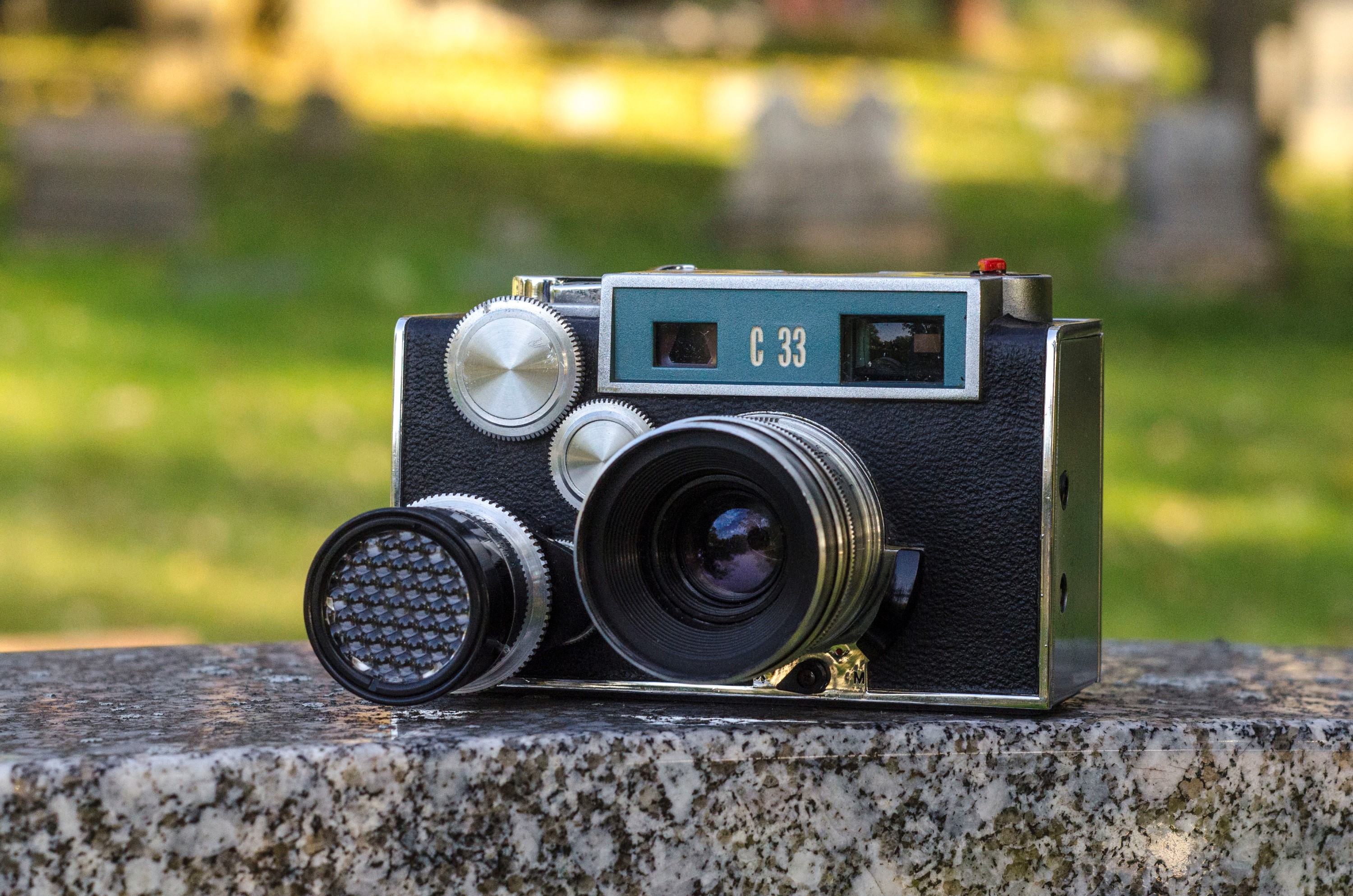
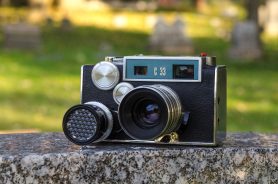
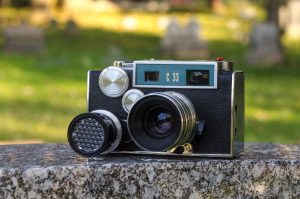
















Nice to see a proper review of the C-33. I used to have a large Argus collection, including that model, and could never bring myself to use it. By far, my favorite “user” Argus is the C-4, that operates pretty much like a camera should. It’s easy to see why the new cameras from Japan and Europe pretty much killed the US-made Argus line.
Im glad you enjoyed the review, Mark. As you noted, theres very little info on the C33 out there. It was a poor selling camera that many people aren’t even aware exists. Add to that the typical wear and tear cameras of this age typically have and thats a recipe for obscurity! 🙂
I like that the film counter counts down… but they did improve it for the later autronic models by getting rid of the pin that keeps the door from closing, and cut a little window so you can reset the counter with the back closed, a much better arrangement. I just try to always have 36 exposure rolls to use in it. Too bad your shutter died… not sure how easy that is to fix. It’s one of my favorite cameras, I have 4 of them now. All of them work, although the slow speeds are a tad sticky on some. I bought one that wasDOA, but enough lighter fluid got the shutter working perfecty. Then I bought a second ‘beater’ cause it was cheap, figured then I can leave my pristine one on the shelf and use the beater.. then got another because it had the uncommon f3.5 lens, then just got another because it was a complete kit with WA and TELE lenses, light meter, and rare zoom finder. I don’t need 4, maybe we could trade something.
The C33 does have X sync. That is why they specify such a slow shutter speed for some bulbs. You can shoot bulbs on X Synch if the speed is low enough to allow the bulb to fire. If the shutter really was synced for those bulbs you would
be able to use any speed. Many 50s cameras actually had x sync, not M sync, you can tell when the manual gives a low shutter speed limit for them. The Ciroflex E is an example.
Good to know, thanks for the clarification, Eric!